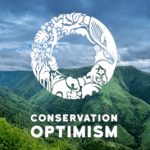A picture tells a thousand words… well, in this case, each picture tells a story of conservation optimism. From orchids to gibbons, we have been collecting photos from conservationists all around the world to inspire us as conservation optimists.
These photos are on display at the 29th International Congress for Conservation Biology (ICCB 2019) in Kuala Lumpur, in a Conservation Optimism photography exhibition co-hosted by the Society for Conservation Biology Malaysia Chapter (SCB-Malaysia) and Turtle Conservation Society of Malaysia (TCS). In case you aren’t attending, we will be posting these photos and their stories throughout the summer!
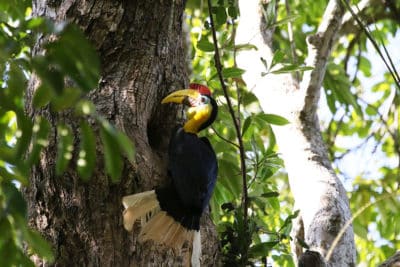
Yeap Chin Aik, the photographer behind this image, works for the Malaysian Nature Society Hornbill Conservation Project (MNSHCP). She didn’t set out to study hornbills but hornbills ‘found’ her in 2004 and led her on a path that she describes as “the most interesting, life-changing, very frustrating but rewarding path.”
The MNSHCP is a pioneer organisation when it comes to hornbill research and conservation in Malaysia and Yeap explains that working on this project meant that the team “had to blaze a new path, making mistakes but still managing to have a meaningful impact.”
In the last 15 years, the project has achieved milestone after milestone and that has fuelled Yeap to keep working towards protecting hornbills. The team is working in the Belum-Temengor Forest Complex, one of only three sites in the world home to 10 hornbill species. Yeap explains that “despite being an iconic forest bird in our tropical rainforest, not much is known about its basic ecological needs.”
Yeap’s photo is a symbol of how the team’s perseverance led to the discovery of a wrinkled hornbill’s nest in Belum-Temengor Forest Complex. This discovery is significant as it is only the second time that such a nest has been found in Malaysia.
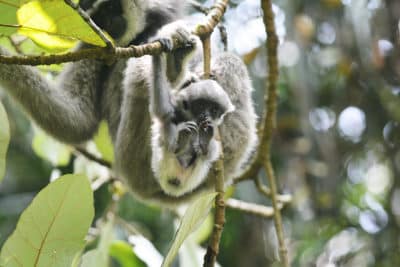
Rahayu Oktaviani’s project is studying the behavioural ecology of the Javan gibbon. The team works closely with the public through conservation education programmes and involving local communities in the conservation of the Javan gibbon and its habitat.
Working with local children has been a source of inspiration for Rahayu.
“Bring them to the field and you will see them in awe and curious!” She says. “This motivates me to do more because I believe they can grow to become conservation agents in their own communities as long as we can build their capacity and increase their sense of belonging to the unique biodiversity that exists in their backyard.”
The little guy in the photo is named Ajaib, which means miraculous, and he is the newest member of the group of wild gibbons that Rahayu and her team are observing. At the time, the researchers were getting worried about the fact that his mum Ayu still hadn’t delivered a baby despite other females with similar birth cycles having done so already. However, Rahayu got a surprise one morning when “there was a bundle of grey fur clinging to Ayu’s belly.”
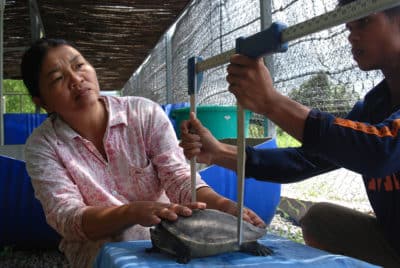
“Tun Sarorn (left in the photo) has been feeding and raising captive royal turtles of Cambodia in Koh Kong Reptile Conservation Center (KKRCC) for more than a decade,” explains the photographer, Bibek Raj Shrestha.
The significance? Royal turtles were thought to be extinct in wild, until they were rediscovered in 2001 in the Sre Ambel River, Cambodia. Since then WCS Cambodia with the Fisheries Administration (FiA) have been running a long term reintroduction programme by allowing turtle eggs to hatch in wild, rearing them in captivity and releasing them once adult.
Bibek’s study monitored the released turtles, looking at their survival rate and habitat association. He recalls that in May 2018, the team watched the tiny turtles hatching in the only known nesting site in the country. The hatchlings were then transported to the Koh Kong Reptile Center where they joined hundreds of other turtles.
The centre is now home to more than 200 critically endangered royal turtles!

The Vanilla montana orchid pictured here was claimed as ‘missing’ for more than a century.
It was first discovered in 1913 by Mr Herbert C. Robinson, the Director of the Federal Malay Museum but since disappeared until it was rediscovered by Farah Alia Nordin, Akmal Raffi and their team in the montane forests of Malaysia in 2017.
Farah, the photographer behind this picture, and Akmal are researching the distribution and ecology of wild orchids in Malaysia. With their team of helpers and students, they leads expeditions into the mountains in search of orchids and explains that even though “there were times when they came back empty-handed, most of the time we returned were truly smitten by the beauty and our orchid discoveries.”
Finding orchids can be a tricky endeavour but Farah remains optimistic and believes that “you just have be observant and persevere.”
The lost and found of V. montana triggered important questions: What else might botanists have missed out? Where else should the team explore? Farah has a call for action for every budding botanist around the world: “The forest has so much to offer. Do not wait. Go for it. Now!”
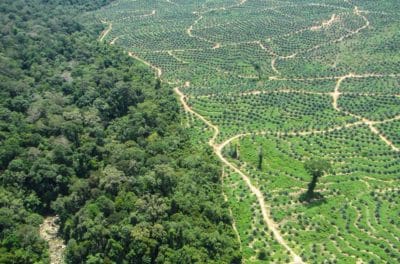
Understanding how orangutan habitat preference is influenced by human land use is an important task. Sol Milne is conducting drone surveys of large areas of forest in Sabah to record nest sites in multiple land-use types to start getting more data on the species’s preference.
Sol explains that: “Our understanding of degraded habitat, in this case logged forest, is mostly based on our perception of what a good habitat should look like.” His research has shown that orangutans can be found using even heavily degraded forest. It also seems that once the land is freed from human disturbance, the animals move back in quickly.
This photo shows a strangler fig tree standing unlogged in the middle of a palm oil plantation. This single tree still has the power to “provide a vital source for hornbills and fruit bats passing through.” Sol explains that even though this image makes him sad thinking about the huge impact the palm oil industry is having regionally, it is also a reminder of “how important the input of individual species into the forest system can be- even just one tree.”
Do you have any photos that tell a story of Conservation Optimism? Share them with us on social media using the hashtag #ConservationOptimism and let us know if you would like to be featured in Conservation Optimism in pictures.
Keep an eye out for the next in the series!


